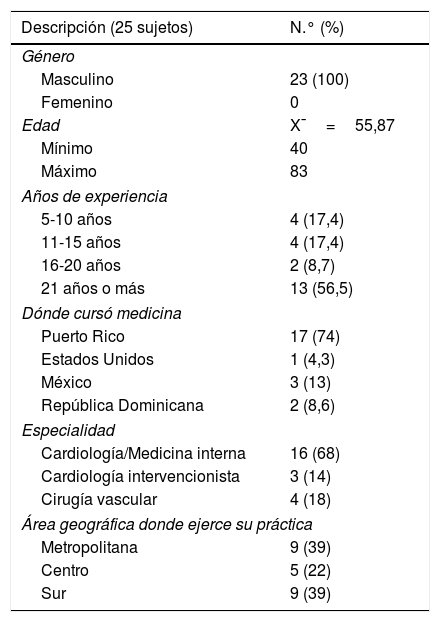Esta investigación buscaba explorar el conocimiento que tiene el cardiólogo sobre el papel del fisioterapeuta en el manejo de pacientes con enfermedad arterial periférica (EAP), conocer los niveles de adherencia del médico a las guías de manejo y tratamiento de pacientes con EAP, determinar los retos que enfrenta para remitir pacientes con EAP al fisioterapeuta e identificar estrategias potenciales para promover el mismo.
MétodosLa investigación fue realizada mediante un enfoque cuantitativo, utilizando un diseño transversal exploratorio, no experimental. Para abordar los objetivos planteados se construyó y validó un cuestionario, el cual fue administrado a 25 médicos con especialidad en cardiología (68%), cardiología intervencionista (14%) o cirugía vascular (18%). Los datos fueron analizados descriptivamente.
ResultadosEl conocimiento del médico cardiólogo sobre el papel del fisioterapeuta tanto en aspectos generales, como en la prevención y manejo de pacientes con EAP, fue de un 70%. El 62% de los médicos solo remiten hasta un 10% de sus pacientes con EAP a fisioterapia. Entre las barreras principales para remitir a estos pacientes se encuentra la poca cobertura por parte de las aseguradoras médicas y el alto costo de los servicios de rehabilitación.
ConclusiónEducar a los cardiólogos sobre el alcance de la fisioterapia puede llevar a que se reconozca su efectividad. Las barreras encontradas pueden llegar a predisponer al paciente a futuras complicaciones. Aunque hay un desconocimiento sobre el fisioterapeuta, existe la disposición del médico a que se le eduque con el fin de utilizar todas las herramientas disponibles para el bienestar del paciente.
This study aims to determine the knowledge of the cardiologist of the physiotherapist (PT) role in the management of patients with peripheral arterial disease (PAD). It also set out to determine the levels of adherence of physicians to the clinical management and treatment guidelines of patients with PAD, as well as to determine the challenges the cardiologist faces when referring patients with PAD to the PT, and to identify potential strategies to promote it.
MethodsThis was a quantitative study, conducted using an exploratory cross-sectional, non-experimental design. To address the proposed objectives, a questionnaire was constructed and validated, which was administered to 25 physicians specialised in cardiology (68%), interventional cardiology (14%), or vascular surgery (18%). A descriptive analysis was performed on the data.
ResultsThe level of physician's knowledge about the role of PT in general and in the prevention and management of patients with PAD was 70%, and 62% of physicians only refer up to 10% of their patients with PAD to the PT. Among the main barriers to referring these patients is the low coverage by health insurance providers, and the high cost of rehabilitation services.
ConclusionEducating cardiologists about the scope of physiotherapy can lead to recognition of its effectiveness. The barriers encountered may predispose the patient to future complications. Although there is a lack of knowledge about the PT, there is a physician's willingness to be educated in order to use all available tools for the patient's well-being.
Artículo
Si ya tiene sus datos de acceso, clique aquí.
Si olvidó su clave de acceso puede recuperarla clicando aquí y seleccionando la opción "He olvidado mi contraseña".Comprando el artículo el PDF del mismo podrá ser descargado
Precio 19,34 €
Comprar ahora












